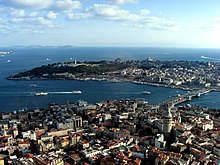Galata (Istanbul)

Galata (now Karaköy) is a district on the European side of Istanbul in the Beyoğlu district .
Similar to Gaul or Iberian Galicia , the name indicates the early settlement by Celts ( Galatians ). Spectacular buildings like the built in place of the same historic bridge Galata Bridge or the Galata Tower retain that name as well as the elite school Galatasaray and the sports club Galatasaray Spor Kulübü (football, basketball, water polo, volleyball, etc.).
history
In Byzantine times, Galata was a separate city on the northern bank of the Golden Horn . Just 400 meters from Byzantium , Galata was on the north side of the Golden Horn at the port of Constantinople , at the crossroads of three bodies of water: the Bosporus , Sea of Marmara (Propontis) and Golden Horn.
Called Konstantin Opel today "historic peninsula of Istanbul", the Orthodox and Islamic was the imperial capital of the Eastern Roman and Ottoman Empire, however, the Galata genuesisch- Italian - Catholic commercial town with its own city wall.
Galata was considered the largest Genoese trading colony outside of the Latin cultural area. The richest Genoese merchants and bankers who traded with the Orient lived here.
During the conquest and subsequent plundering of Constantinople by Sultan Mehmed II in 1453, the Genoese Galata behaved neutrally towards the Ottoman rulers according to the treaty, and the latter also respected this agreement during the siege. After the storming of the metropolis, Galata surrendered on the same day
With the part Pera ( Beyoğlu ) Galata formed the other European side to the nevertheless European historical Constantinople . The district's Jewish character at times can be seen in the synagogues still in operation today, such as the Neve Shalom or the High Rabbinate.
During the First World War , there was an airfield here, which the German air force also used. After the war, Galata was expanded into an alternative imperial capital by the victorious powers Great Britain and France.
The Grande Rue de Pera ( İstiklal Caddesi ) and the area ( Beyoğlu / Cihangir / Tophane ) still have one of the world's largest collections of Art Nouveau houses . The owners of these listed houses were mostly French or Italian bankers and Ottoman Greeks.
sons and daughters of the town
- André Chénier , French writer, born "in the Han von St. Pierre at the Ottomanbank " ( Friedrich Schrader : Constantinople in the past and present. Mohr / Siebeck, Tübingen 1919, p. X.)
literature
- Edhem Eldem : Ottoman Galata and Pera between myth and reality. In: Ulrike Tischler (ed.): From “milieu de mémoire” to “lieu de mémoire”. The cultural memory of Istanbul in the 20th century. Martin Meidenbauer Verlagbuchhandlung, Munich 2006, ISBN 3-89975-063-2 , pp. 19–36 ( online ).
Web links
- Galata and the Galata Bridge (Engl.)
- Jewish Sites in Galata, Istanbul (English)
Individual evidence
- ↑ Stefan Zweig: Great moments of mankind. Project Gutenberg - DE, accessed on November 3, 2019 (German).
- ↑ Milestone project. Stadthemeinde Woergl, accessed on November 3, 2019 (German).
Coordinates: 41 ° 1 ′ N , 28 ° 58 ′ E

